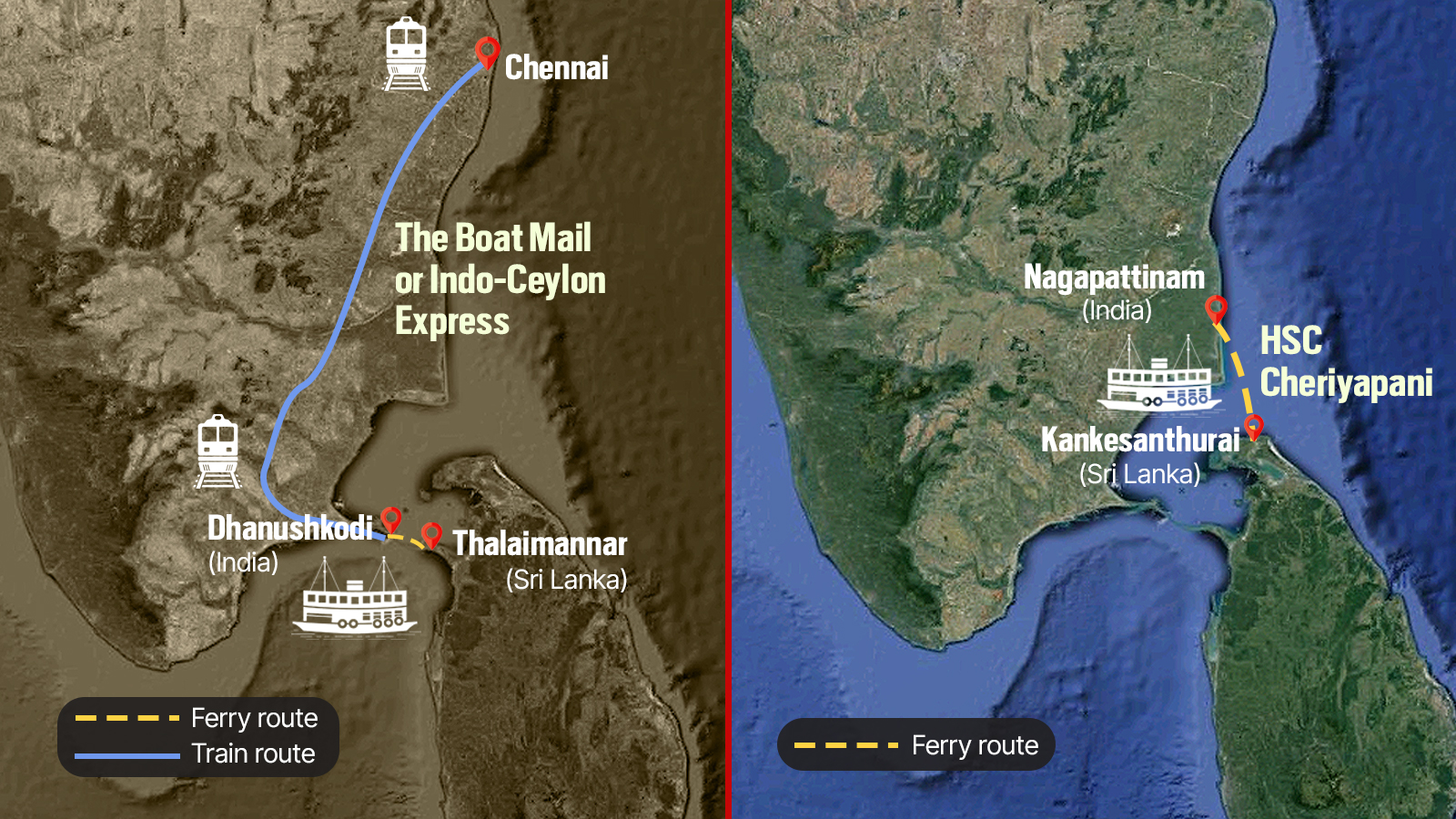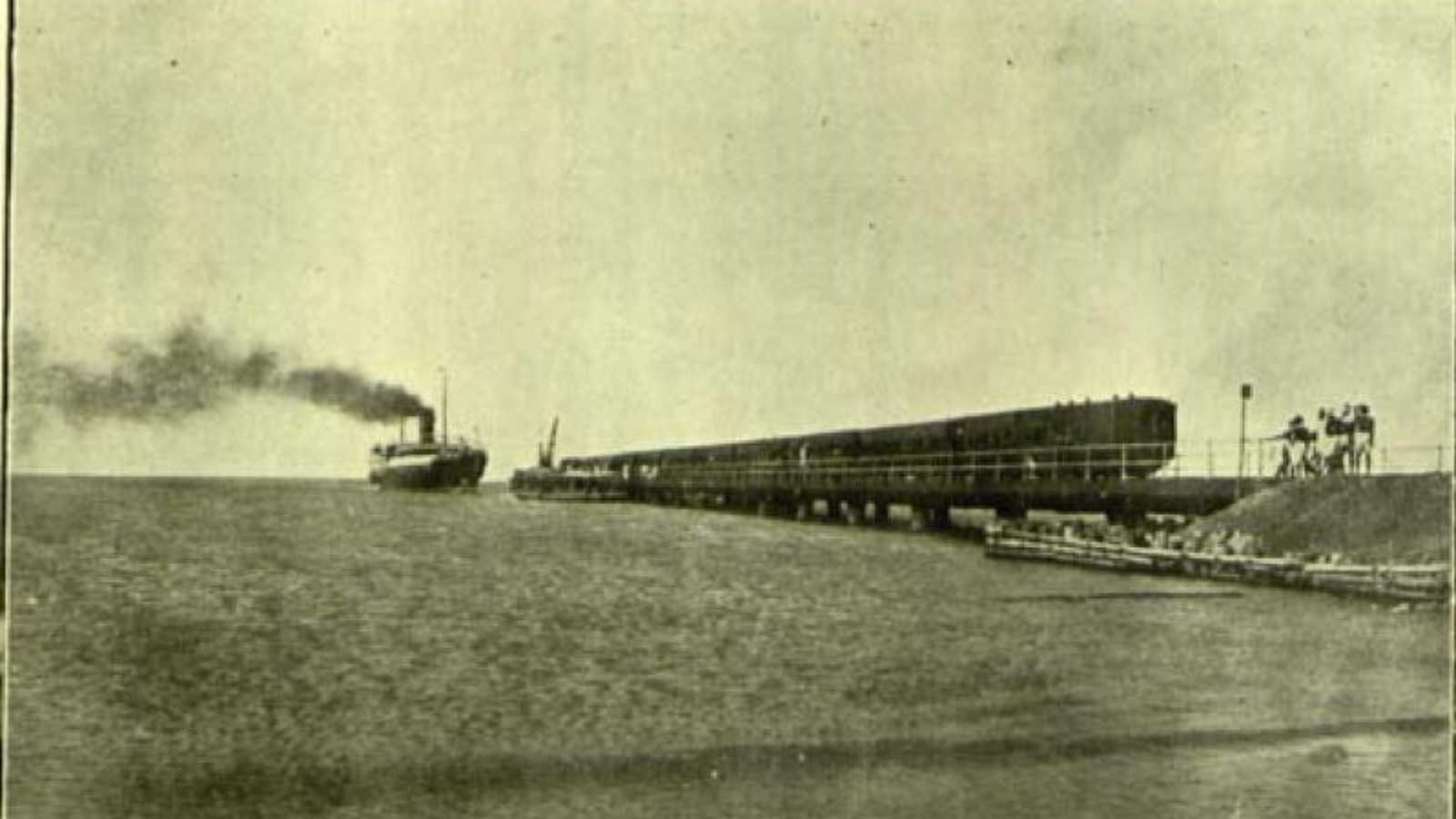History, as eminent historian Romila Thapar once said, is an ‘understanding’ of the past. Accordingly, the inauguration of the ferry route between Nagapattinam (India) and Kankesanthurai (Sri Lanka) demands to be understood as much more than a nostalgic throwback to the memory of the Boat Mail, an express train that once used to connect Madras and Colombo (originally via Tuticorin or Thoothukoodi and later via Dhanushkodi).
Given the prized endorsements that the ferry route has received from Prime Minister Narendra Modi and Sri Lankan President Ranil Wickremesinghe, there is more to its history and present-day ramifications than meets the eye. The small infrastructural move, on the back of the high-speed craft, unassumingly named ‘HSC Cheriyapani’, does not merely signal the renormalisation of bilateral trade-and-traffic ties. It also represents a mutually favourable ongoing cultural reconciliation between the neighbours while shadows of global geopolitical unpredictability loom large in the Indian Ocean region.

The Boat Mail’s Cultural Legacy
Back in the late 1960s, Indo-Lankan relations began souring (predominantly over the Tamil question) until they were resolved with the termination of the Lankan civil war in 2008-09. In stark contrast, the Boat Mail belonged to times when Indian and Sinhalese legacies enjoyed pluralistic harmony.
In the 1880s — when the combined exports of Indian and Ceylonese teas eclipsed Chinese tea exports to Britain, before tea companies such as Lipton’s began buying Ceylonese plantations and hiring Indian Tamil labour — the South Indian Railway and the Ceylon Government Railway were eager to develop railway linkages between the two administrations.
On January 1, 1880, a new train was inaugurated between Madras and Tuticorin (a journey of less than 22 hours) — on the route of the present-day Pearl City Express — with a day-long steamer connection to Colombo. In February 1914, the Pamban Bridge, designed by American engineer William Scherzer, was inaugurated. Following this, a new train route was started from Madras to Dhanushkodi, with a 22-mile ferry route connecting Dhanushkodi with Thalaimannar, thus leading to the birth of the Ceylon India Boat Mail Express. According to The Boston Evening Transcript, it put an end to the ‘misery and sea-sickness of the long sea journey between Colombo and Tuticorin’. Named after three British Viceroys (Curzon, Elgin, and Harding), and inaugurated by the Governor of Madras, Lord Petland, in April 1914, the Boat Mail was to be the precursor to the colonial railway bridge across Adam’s Bridge that the British regime kept planning but could never execute.
Nevertheless, until 1964, the Boat Mail continued to be an prominent reminder of shared Indo-Lankan heritage and Hindu-Buddhist unity. Its tickets used Tamil, Sinhalese, and English scripts, and the train used to have special carriages reserved for monks, making sacred sites such as Bodh Gaya, Sarnath, Rameswaram, and Jaffna closer to pilgrims from both nations and religious denominations.
According to the Tamil Nadu District Gazetteers (1972), Dhanushkodi, which once formed the terminus of the Southern Railway, was “the gateway from India to Ceylon”. The principal articles of trade imports included “areca nuts, sugar, coconuts, machinery, tea, raw hides and skins, spices, empty jute gunny bags and oil seeds”, and the “bulk of the export trade consist[ed] of rice, onion, cotton piece goods, salted fish, tea, coffee, oil cakes, bones and bone meal, vegetables and fish manure”.
Although the Boat Mail still plies between Chennai and Rameswaram, its pluricultural legacy was halted first by the 1964 Rameswaram-Dhanushkodi cyclone (which destroyed the Pamban Bridge and Dhanushkodi, including its railway station) and then the outbreak of the Lankan civil war against the Liberation Tigers of Tamil Eelam, in 1983.
Rethinking Sethusamudram
The Boat Mail had a much greater expanse than the 64-nautical-miles-long ferry route (74 miles) between Tamil Nadu’s Nagapattinam and Jaffna’s Kankesanthurai. Nevertheless, besides recalling the former’s glory to mind, the latter entails great nautical and political advantages.
For one, the Cheriyapani ferry service is a cut above the Scotia Prince luxury cruise started in 2011 between Thoothukoodi and Colombo before being indefinitely suspended due to the absence of takers. At less than $95 (around Rs 7,600) for a one-way ticket, the Nagapattinam-Kankesanthurai ferry journey saves about 740 miles and over 40 hours between the two ports — given that the existing maritime route meant practically circling Sri Lanka, via the ports of Trincomalee, Batticaloa, Galle, Colombo, and then via the inland town of Dambulla and Anuradhapura. Populating the shallow littoral territory between Tamil Nadu and Jaffna — also known as Palk Strait with its adjoining Sethusamudram region — with Indo-Lankan traffic can somewhat satisfy the demands of the Tamil Nadu government for greater connectivity for Tamils on both sides of the strait. If administered well, its tourism potential could diversify employment opportunities for the overstressed Tamil fishing communities. Since Nagapattinam and Jaffna share ancient cultural ties, legendarily believed to contain the abodes of ‘Naga’ people — according to Sanskrit, Pali, Tamil, Puranic, and Buddhist literatures — the new route can also galvanise civilisational memories. The route also promises to be a sustainable prospect for Catholic and Muslim pilgrimages given the presence of the Velannkani Minor Basilica (close to Nagapattinam) and Nagapattinam’s Nagore Dargah (built after the sixteenth-century Sufi saint Syed Shahul Hameed, by his Muslim and Hindu devotees).
Most Read 1Leo box office collection Day 9: Vijay-starrer in freefall, fails to register uptick on second Friday as it chases Rajinikanth’s Jailer 2Deepika Padukone says she and Ranveer Singh were ‘technically allowed’ to date other people ‘until he proposed’: ‘There was no real commitment’ 3Sutapa Sikdar says son Babil Khan joining films was ‘heartbreaking’, calls her marriage with Irrfan Khan ‘a partnership’ 4Jamiat concerned over Modi’s expected participation in Ram Temple ceremony, says PM should avoid such events 5Australia vs New Zealand Highlights, World Cup 2023: AUS win high-scoring encounter against NZ by five runs The Boat Mail connecting Chennai and Thalaimannar in Sri Lanka via Dhanushkodi (left) and the HMS Cheriyapani connecting Nagapattinam in Tamil Nadu and Kankasanthurai in Sri Lanka (right).
The Boat Mail connecting Chennai and Thalaimannar in Sri Lanka via Dhanushkodi (left) and the HMS Cheriyapani connecting Nagapattinam in Tamil Nadu and Kankasanthurai in Sri Lanka (right).
Finally, and perhaps most importantly, the ferry route may be the keystone of incremental littoral collaborations between the two neighbours that could substitute the political Tamil dream of an otherwise unsustainable Sethusamudram Shipping Canal across the shallow waters of the Adam’s Bridge — a canal whose geostrategic importance in countering the growing naval presence of aggressive Asian players needs little explanation.
Since 2011, Indian and Sri Lankan actors have toyed with plying ferry services while the administrations of the two nations actively engaged in bilateral dialogues over maritime trade, environmental diplomacy, and economic ties — not to mention India’s unconditional monetary aid in times of Lankan distress. It would be an exaggeration to decode the Cheriyapani ferry service as the escalation of Indo-Lankan seabed critical infrastructure. However, given the resurgence of the importance of seabed infrastructure in recent conflicts (Ukraine versus Russia, for instance), Indo-Lankan stakeholders will be obliged to acknowledge the Sethusamudram region as a ground of natural critical seabed asset legacies for both nations, stretching across millennia.
Also ReadWhy Islamic State in Afghanistan harks on the concept of Khorasan and wha…Here is everything you need to know about Indian JewsFrom Vivekananda to Motilal Nehru: The Indian leaders believed to have jo…Why Sanskrit has strong links to European languages and what it learnt in…
As Lankan historian Mudaliyar C. Rasanayagam remarked in Ancient Jaffna (1926), “in remote antiquity, the coasting trade from one half of Asia to the other half must have passed by the deep passages across the Adam’s Bridge or by the Straits of Mannar, and consequently, a great port must have risen on the North-west coast of Ceylon”. Whether or not Cheriyapani marks a historic event will be seen. Undoubtedly, however, its arrival on the South Asian littoral stage comes at a time when the history of Indo-Lankan maritime legacies is being understood afresh.
© The Indian Express Pvt Ltd



